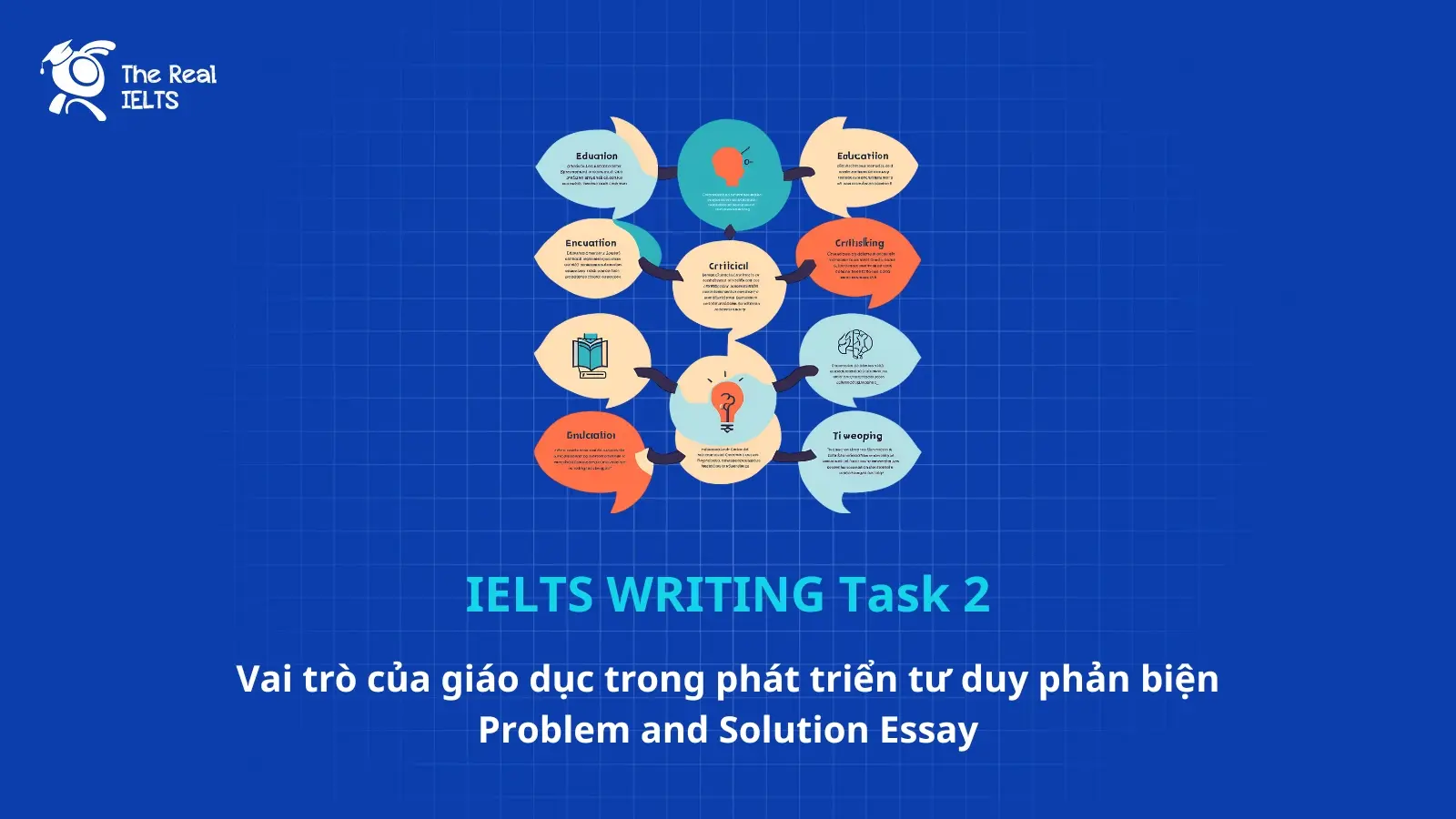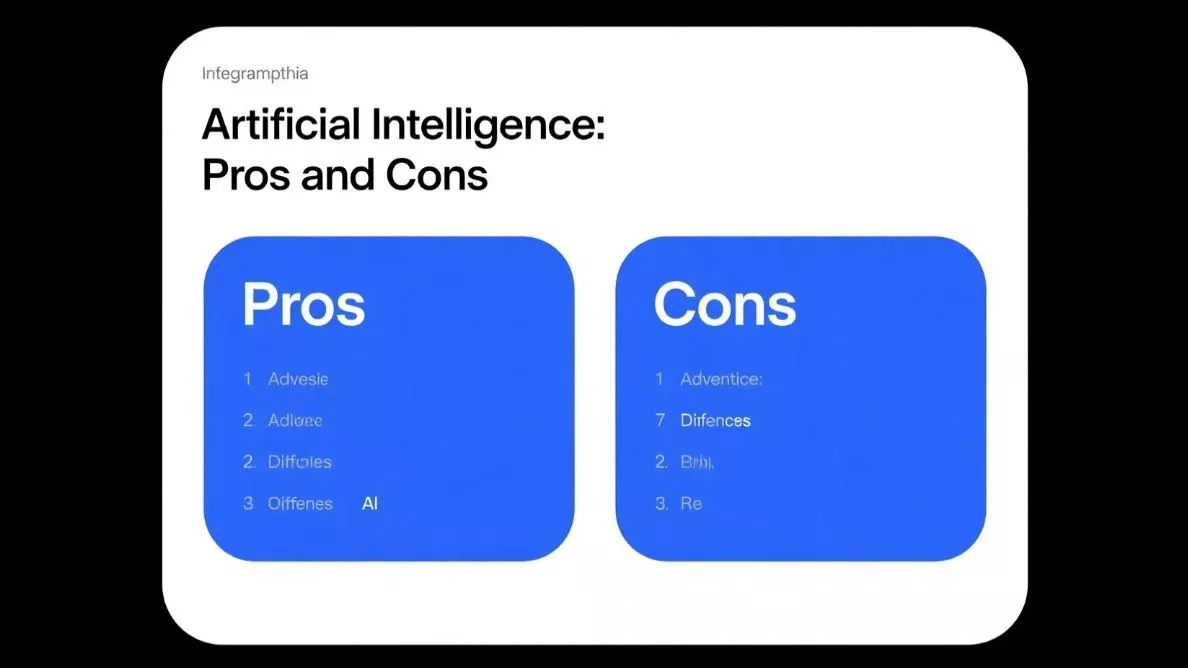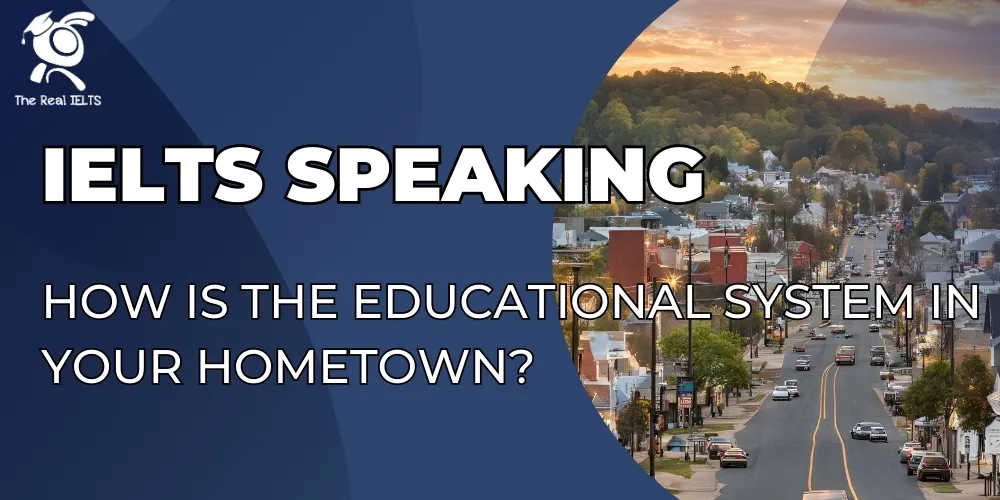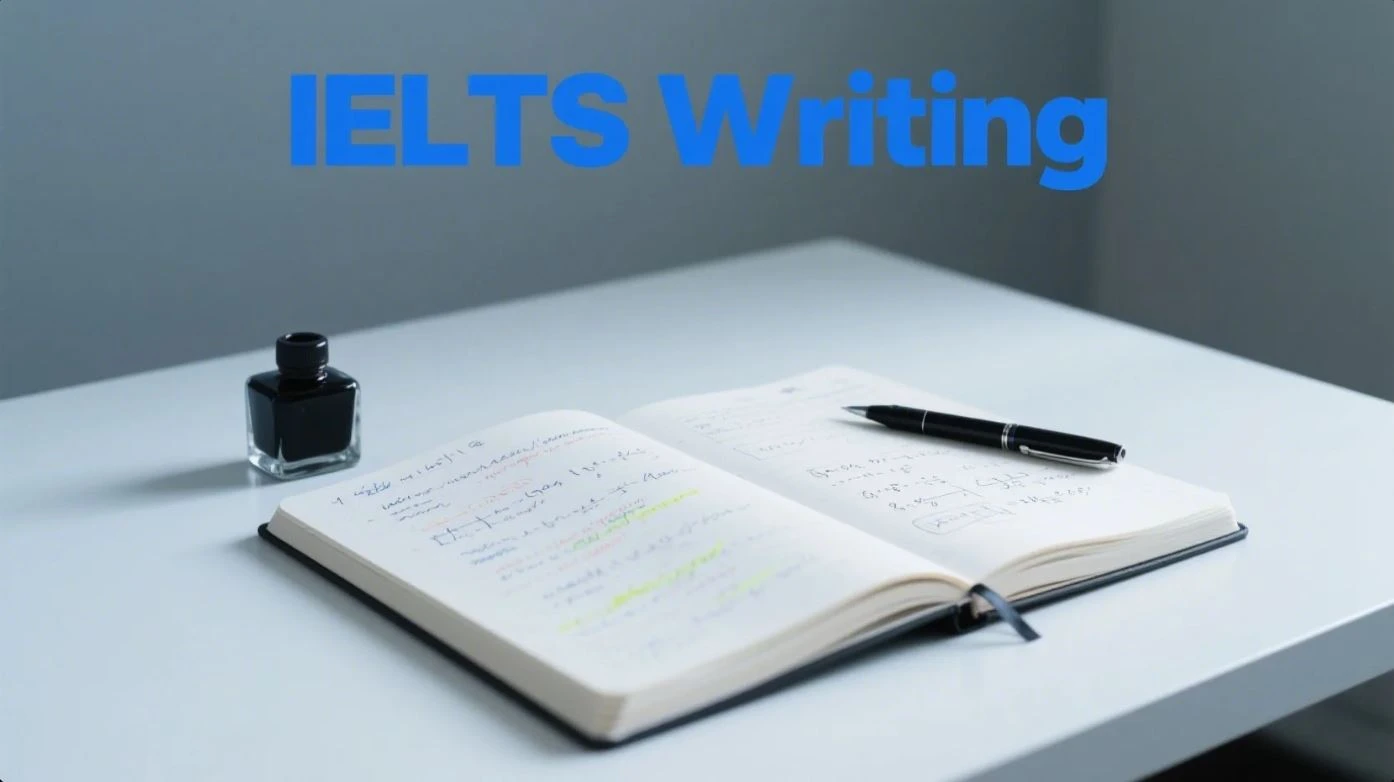IELTS Writing Task 2 dạng Problem and Solution Essay yêu cầu xác định vấn đề và đề xuất giải pháp. Nhiều người cho rằng giáo dục chưa thực sự phát huy hiệu quả trong việc phát triển tư duy phản biện. Vậy nguyên nhân là gì và làm thế nào để cải thiện? Bài viết sau sẽ phân tích vấn đề này.
Đề bài IELTS Writing Task 2: Vai trò của giáo dục trong phát triển tư duy phản biện – Problem and Solution Essay
Although education aims to enhance critical thinking, many students graduate without strong analytical skills. What are the reasons for this issue, and what solutions can be implemented?
Ví dụ 1
Introduction
Despite the aim of education to develop critical thinking skills, many students graduate without possessing strong analytical abilities. This issue has become increasingly prominent, as the traditional education system often fails to nurture these skills effectively. In this essay, I will explore the reasons behind this problem and suggest solutions that could help improve the development of critical thinking in students.
Body Paragraph 1: Reasons for Weak Analytical Skills in Graduates
One significant reason is the overemphasis on rote learning and memorization within many education systems. In traditional classrooms, students are often required to memorize facts and figures rather than engage in deep analysis or problem-solving. This focus on regurgitation of information limits opportunities for students to apply critical thinking skills, which are necessary for real-world problem solving.
Another factor is the lack of emphasis on interactive and student-centered learning methods. Many educational systems still rely heavily on lectures and passive learning, where students are expected to absorb knowledge without actively participating in discussions or debates. Without the chance to question, debate, and analyze, students miss out on the development of key analytical skills.
Body Paragraph 2: Potential Solutions to Improve Critical Thinking
To address these challenges, education systems should incorporate more active and inquiry-based learning methods. For instance, project-based learning, group discussions, and case studies encourage students to engage with complex issues, think critically, and collaborate with others. These approaches help students develop a deeper understanding of the subject matter while honing their problem-solving abilities.
Additionally, it is essential to shift the focus from memorization to skill development. Educators should prioritize teaching students how to analyze, evaluate, and synthesize information rather than just recall it. Incorporating activities that challenge students to think critically, such as debates, essays, and real-world case scenarios, can help nurture these abilities.
Finally, fostering a culture of critical thinking outside the classroom is equally important. Encouraging students to engage in extracurricular activities, such as reading, writing, and participating in discussions or debates, can help develop their analytical thinking further.
Conclusion
In conclusion, the lack of strong critical thinking skills in graduates can be attributed to outdated educational methods, such as rote learning and passive classroom environments. To address this, education systems must adopt more interactive, student-centered teaching techniques that promote problem-solving and analytical thinking. By making these changes, we can better equip students with the critical thinking skills needed to navigate the complexities of the modern world.
Ví dụ 2
Education is widely believed to cultivate critical thinking, yet many students complete their studies without developing strong analytical skills. This issue stems from various factors, including traditional teaching methods and systemic educational shortcomings. However, several solutions can be implemented to address this problem effectively.
One of the main reasons for this issue is the emphasis on rote memorization rather than analytical reasoning. In many education systems, students are required to absorb and reproduce large amounts of information for standardized exams rather than being encouraged to question, evaluate, and apply their knowledge. As a result, they develop a habit of passive learning rather than active problem-solving, which limits their ability to think critically.
Another contributing factor is the lack of practical application in many academic programs. While theoretical knowledge is essential, critical thinking skills are best developed through hands-on experiences, real-world problem-solving, and open-ended discussions. However, many curricula focus heavily on textbook-based learning, offering few opportunities for students to engage in debates, case studies, or research projects that require deep analysis. Additionally, in some countries, large class sizes and outdated teaching methods prevent teachers from fostering an interactive learning environment where students can develop independent thought.
To address this issue, education systems should shift toward inquiry-based learning. Schools and universities should encourage students to ask questions, explore different viewpoints, and engage in problem-solving activities rather than simply memorizing facts. For instance, incorporating debate sessions, case studies, and project-based learning into the curriculum can help students develop their analytical abilities.
Furthermore, teachers should be trained to adopt modern pedagogical approaches that prioritize critical thinking. Professional development programs can equip educators with strategies to create interactive and thought-provoking lessons that challenge students to think independently. Additionally, assessment methods should be revised to evaluate students’ ability to analyze and synthesize information rather than just recall facts.
In conclusion, while education aims to develop critical thinking, many students graduate without strong analytical skills due to rote learning and a lack of practical application. By integrating inquiry-based learning, training teachers in modern teaching methods, and revising assessment criteria, education systems can better equip students with the critical thinking skills necessary for success in the modern world.
Ví dụ 3
Introduction
While education is intended to foster critical thinking, many students graduate without strong analytical skills. This issue limits their ability to solve problems, evaluate information, and make sound decisions in their professional and personal lives. This essay explores the reasons behind this problem and suggests possible solutions to improve critical thinking in education.
Reasons Why Many Graduates Lack Critical Thinking Skills
- Overemphasis on Memorization and Standardized Testing
- Many education systems prioritize rote learning and exam performance over analytical thinking.
- Students often focus on recalling facts rather than questioning concepts or developing independent reasoning.
- Traditional Teaching Methods
- Lecture-based teaching discourages interactive learning and critical discussions.
- A lack of opportunities for debate, inquiry-based learning, and problem-solving activities limits students’ ability to think critically.
- Limited Exposure to Real-World Applications
- Many curricula focus on theoretical knowledge rather than practical applications.
- Without hands-on learning, students struggle to apply their knowledge to real-world challenges.
- Lack of Encouragement for Independent Thinking
- Some cultures and educational systems emphasize conformity over questioning authority.
- Students may be discouraged from expressing different viewpoints or challenging existing ideas.
- Insufficient Teacher Training in Critical Thinking Instruction
- Many educators are not trained in techniques that foster analytical reasoning.
- Teaching methods often lack strategies to encourage inquiry, discussion, and problem-solving.
Solutions to Improve Critical Thinking in Education
- Shift from Memorization to Inquiry-Based Learning
- Curriculum reforms should emphasize critical thinking, problem-solving, and analytical reasoning.
- Assignments and assessments should require students to evaluate arguments and justify their reasoning.
- Adopt Interactive and Discussion-Based Teaching Methods
- Encourage debates, case studies, and group discussions to promote logical reasoning.
- Use project-based learning to help students apply knowledge to real-world situations.
- Integrate Real-World Problem Solving
- Schools should incorporate practical applications of theories, such as simulations and hands-on projects.
- Internships and industry collaborations can expose students to real-world decision-making.
- Train Educators in Critical Thinking Instruction
- Provide professional development programs for teachers on how to incorporate analytical skills into lessons.
- Encourage educators to use open-ended questions and Socratic questioning techniques.
- Encourage Independent Learning and Creativity
- Allow students to explore topics of interest through research projects and self-directed learning.
- Provide access to diverse perspectives and encourage students to analyze different viewpoints.
Conclusion
The lack of critical thinking skills among graduates results from rigid educational structures, outdated teaching methods, and a focus on memorization rather than analysis. To address this, educational institutions must prioritize inquiry-based learning, interactive teaching methods, and real-world applications. Additionally, training educators to foster independent thinking will help students develop the analytical skills necessary for success in both academic and professional settings.
Ví dụ 4
Introduction
Education is intended to develop critical thinking skills, enabling students to analyze information, solve problems, and make informed decisions. However, many graduates struggle with analytical thinking despite years of formal education. This essay will explore the reasons behind this issue and propose potential solutions.
Reasons Why Many Graduates Lack Strong Critical Thinking Skills
- Emphasis on Rote Memorization – Many education systems prioritize memorization and standardized testing over analytical thinking, leaving students with limited opportunities to develop reasoning skills.
- Lack of Practical Application – Traditional teaching methods often focus on theory rather than real-world problem-solving, preventing students from applying critical thinking in practical scenarios.
- Rigid and Teacher-Centered Learning – In some classrooms, students passively receive information without being encouraged to question, debate, or explore alternative viewpoints.
- Limited Exposure to Open-Ended Problems – Many curricula emphasize finding the “right” answer instead of encouraging students to explore different solutions and perspectives.
- Insufficient Training for Educators – Some teachers may not have the necessary training or teaching strategies to promote critical thinking effectively in their classrooms.
Solutions to Improve Critical Thinking Skills in Education
- Shift from Memorization to Inquiry-Based Learning – Schools should adopt teaching methods that encourage students to ask questions, evaluate evidence, and engage in independent thinking.
- Integrate Real-World Problem-Solving – Practical case studies, project-based learning, and hands-on experiences should be included in curricula to help students apply analytical skills in real-life situations.
- Encourage Debate and Discussion – Classrooms should provide a space for open discussions, debates, and group activities where students can develop reasoning and argumentation skills.
- Train Teachers to Foster Critical Thinking – Educators should receive professional development to implement teaching strategies that promote inquiry, analysis, and independent thought.
- Use Diverse Assessment Methods – Instead of relying solely on multiple-choice tests, assessments should include essays, problem-solving tasks, and open-ended projects that require students to think critically.
Conclusion
While education aims to develop critical thinking, many graduates lack strong analytical skills due to rote learning, lack of practical application, and rigid teaching methods. To address this issue, education systems must prioritize inquiry-based learning, real-world problem-solving, and teacher training. By fostering a more interactive and thought-provoking learning environment, students can graduate with the critical thinking skills needed for success in their careers and everyday lives.
Ví dụ 5
Education is intended to develop critical thinking, yet many students graduate without strong analytical skills. This issue affects their ability to solve problems, make informed decisions, and adapt to real-world challenges. This essay explores the reasons behind this problem and suggests solutions to ensure that education effectively enhances critical thinking.
Reasons Why Many Graduates Lack Critical Thinking Skills
- Memorization-Based Learning
Many education systems prioritize rote memorization over analytical thinking. Students are often required to recall facts and follow rigid formulas rather than engage in deep analysis or problem-solving. - Standardized Testing Focus
Schools and universities frequently emphasize standardized tests, which measure factual knowledge rather than reasoning abilities. As a result, students focus on passing exams rather than developing independent thought. - Lack of Interactive and Inquiry-Based Teaching Methods
Traditional lecture-based teaching methods often discourage active participation. When students are not encouraged to ask questions, debate ideas, or engage in discussions, they miss opportunities to develop critical thinking skills. - Limited Real-World Application
Many academic programs do not integrate real-world scenarios or hands-on learning experiences. Without exposure to practical problem-solving, students struggle to apply theoretical knowledge in real situations. - Over-Reliance on Authority and One-Sided Perspectives
In some educational settings, students are taught to accept information from textbooks and instructors without questioning or evaluating alternative viewpoints. This discourages independent thinking and intellectual curiosity. - Large Class Sizes and Lack of Individual Attention
In overcrowded classrooms, teachers may not have the time to engage students in meaningful discussions or critical analysis. Personalized feedback, which is essential for developing analytical skills, is often lacking.
Solutions to Improve Critical Thinking in Education
- Shifting from Memorization to Analytical Learning
Educational institutions should focus on teaching students how to think rather than what to think. Incorporating open-ended questions, problem-solving exercises, and debate activities can enhance critical thinking. - Reforming Assessment Methods
Instead of relying solely on standardized tests, schools should use assessments that measure reasoning skills, creativity, and problem-solving abilities. Essays, case studies, and research projects can better evaluate students’ analytical thinking. - Encouraging Inquiry-Based and Discussion-Driven Learning
Teachers should adopt interactive teaching methods, such as Socratic questioning, group discussions, and hands-on projects, to encourage students to analyze information and develop their own conclusions. - Integrating Real-World Applications
Schools and universities should include case studies, internships, and experiential learning opportunities to help students apply their knowledge to practical situations. This approach bridges the gap between theory and practice. - Promoting Independent Thinking and Diverse Perspectives
Educators should expose students to multiple viewpoints and encourage them to evaluate arguments critically. This can be achieved through debate programs, philosophy courses, and interdisciplinary learning. - Reducing Class Sizes and Providing Individual Feedback
Smaller class sizes allow for more personalized instruction, giving students greater opportunities to engage in discussions, ask questions, and receive constructive feedback on their reasoning skills.
Conclusion
While education aims to enhance critical thinking, many graduates lack strong analytical skills due to memorization-based learning, standardized testing, and limited real-world application. By reforming teaching methods, assessments, and learning environments, schools can better equip students with the critical thinking skills needed for academic, professional, and personal success. A well-rounded education that fosters inquiry, discussion, and real-world engagement is essential for producing independent thinkers who can navigate complex challenges.
Ví dụ 6
Introduction
Education is designed to develop students’ critical thinking and analytical skills, yet many graduates enter the workforce lacking these essential abilities. This raises concerns about the effectiveness of current educational systems in fostering independent thought. This essay will examine the reasons behind this issue and propose solutions to ensure students develop strong critical thinking skills.
Reasons Why Graduates Lack Strong Analytical Skills
- Memorization-Based Learning – Many education systems prioritize rote memorization and standardized testing over analytical thinking. Students focus on recalling facts rather than developing problem-solving abilities.
- Lack of Practical Application – Many academic programs emphasize theoretical knowledge without encouraging real-world problem-solving. Without hands-on experience, students struggle to apply critical thinking in real-life situations.
- Passive Learning Methods – Traditional lecture-based teaching often involves students passively receiving information rather than engaging in discussions, debates, or inquiry-based learning that strengthens analytical skills.
- Limited Exposure to Diverse Perspectives – Critical thinking flourishes when students engage with multiple viewpoints and challenge assumptions. However, some curricula lack interdisciplinary approaches, restricting students from exploring alternative ways of thinking.
- Time Constraints and Exam Pressure – Many students focus on passing exams rather than truly understanding concepts. High academic pressure often discourages deeper analysis and exploration of ideas.
Solutions to Improve Critical Thinking Skills in Education
- Shift from Rote Learning to Analytical Teaching Methods – Schools and universities should emphasize open-ended questions, problem-solving exercises, and debates instead of focusing solely on memorization and standardized testing.
- Incorporate Real-World Applications – Educators should integrate case studies, hands-on projects, and internships to help students apply critical thinking in practical situations. This can bridge the gap between theory and practice.
- Encourage Active Learning – Interactive teaching methods, such as group discussions, peer reviews, and inquiry-based learning, should be prioritized to engage students in critical analysis and reasoning.
- Promote Cross-Disciplinary Education – Introducing students to a variety of disciplines, such as philosophy, logic, and data analysis, can enhance their ability to think critically by exposing them to different perspectives and reasoning approaches.
- Reduce Exam Pressure and Encourage Conceptual Learning – Education systems should focus on evaluating students based on their analytical and problem-solving skills rather than their ability to memorize facts. Alternative assessment methods, such as research projects and presentations, can help achieve this.
Conclusion
Despite education’s goal of fostering critical thinking, many students graduate without strong analytical skills due to memorization-based learning, lack of practical application, and passive teaching methods. To address this, educational institutions must adopt interactive, real-world, and interdisciplinary learning approaches that encourage independent thinking and problem-solving. By implementing these reforms, education can truly develop the critical thinkers needed in today’s rapidly changing world.
Ví dụ 7
Despite the emphasis on critical thinking in education, many students graduate without strong analytical skills. This issue arises due to several factors related to teaching methods, curriculum design, and the broader learning environment. However, there are practical solutions that can help address this problem.
Reasons for Weak Analytical Skills Among Graduates
- Memorization-Based Learning – Many education systems prioritize rote memorization over analytical reasoning, discouraging students from questioning information and forming independent conclusions.
- Rigid Curriculums – Standardized tests and structured syllabi often focus on factual recall rather than problem-solving, limiting opportunities for critical thinking.
- Lack of Real-World Application – Many academic programs emphasize theoretical knowledge without connecting lessons to real-life situations, preventing students from applying their learning effectively.
- Limited Engagement in Discussions and Debates – Some classrooms lack interactive learning approaches such as debates, open-ended discussions, and case studies, which are essential for developing analytical skills.
- Over-Reliance on Educators – In some educational settings, students are not encouraged to challenge ideas or think independently, leading to passive learning habits.
- Unequal Access to Quality Education – Differences in educational quality, resources, and teaching styles result in disparities in students’ ability to develop strong analytical skills.
Solutions to Improve Analytical Skills in Graduates
- Promote Critical Thinking in Curriculum – Schools should incorporate problem-solving exercises, analytical discussions, and research-based projects into their programs to encourage deeper thinking.
- Shift from Memorization to Application-Based Learning – Educators should emphasize application-based learning through case studies, simulations, and hands-on projects.
- Encourage Interactive Learning Methods – More focus should be placed on debates, group discussions, and inquiry-based teaching to develop reasoning skills.
- Integrate Real-World Scenarios in Education – Schools and universities should include practical assignments, internships, and interdisciplinary projects that require students to think critically and solve real-life problems.
- Train Educators in Critical Thinking Methods – Teachers should be trained to facilitate inquiry-driven lessons, fostering an environment where students are encouraged to ask questions and challenge ideas.
- Reduce Over-Reliance on Standardized Testing – Assessment methods should evaluate problem-solving abilities, creativity, and analytical reasoning rather than just factual recall.
- Encourage Self-Directed Learning – Students should be motivated to explore topics beyond the syllabus through independent research, reading, and participation in analytical discussions.
Conclusion
While education is designed to develop critical thinking, many graduates struggle with analytical skills due to rigid teaching methods and curriculum limitations. To address this, schools and universities must prioritize interactive learning, real-world applications, and a shift from rote memorization to analytical reasoning. By implementing these changes, education can better equip students with the critical thinking skills necessary for success in their personal and professional lives.
Ví dụ 8
Education is intended to develop critical thinking skills, yet many students graduate without strong analytical abilities. This issue raises concerns about the effectiveness of traditional teaching methods in preparing students for complex problem-solving and independent thought. This essay will explore the reasons behind this problem and suggest possible solutions.
Reasons Why Students Lack Critical Thinking Skills
One major reason is the overemphasis on rote memorization in many education systems. Standardized testing and rigid curricula often prioritize the ability to recall facts rather than the ability to analyze information critically. As a result, students may excel in exams but struggle to apply their knowledge in real-world situations.
Another contributing factor is the passive learning environment in many classrooms. Traditional lecture-based teaching methods often encourage students to absorb information without questioning or evaluating it. When students are not actively engaged in discussions, debates, or problem-solving exercises, they miss opportunities to develop independent thought and analytical skills.
Additionally, some education systems discourage questioning and independent thinking. In cultures where obedience and conformity are highly valued, students may be hesitant to challenge ideas or offer alternative perspectives. This lack of open discussion and debate can hinder the development of critical thinking.
A further issue is the gap between academic knowledge and real-world application. Many students graduate with theoretical knowledge but lack practical experience in analyzing and solving complex problems. Without opportunities to apply their learning in real-life contexts, they may struggle to develop effective analytical skills.
Solutions to Improve Critical Thinking in Education
To address this issue, education systems should adopt more inquiry-based and interactive learning approaches. Encouraging students to engage in discussions, debates, and case studies can help them analyze different perspectives and develop reasoning skills. Schools should emphasize problem-solving exercises that require students to think critically rather than simply memorize information.
Another effective solution is integrating project-based learning and real-world applications into the curriculum. Assignments that require students to conduct research, evaluate evidence, and propose solutions to real-world problems can help bridge the gap between theoretical knowledge and practical skills.
Furthermore, teachers should be trained to foster critical thinking in the classroom. Educators can encourage students to ask questions, analyze arguments, and support their viewpoints with evidence. Providing constructive feedback and guiding students through the reasoning process can also help strengthen their analytical abilities.
Additionally, assessment methods should be reformed to evaluate critical thinking rather than just memorization. Open-ended questions, problem-solving tasks, and analytical essays can better measure a student’s ability to think critically compared to multiple-choice exams.
Conclusion
While education aims to enhance critical thinking, many students graduate without strong analytical skills due to rote learning, passive teaching methods, and a lack of real-world application. By implementing inquiry-based learning, integrating practical experiences, training teachers to promote analytical thinking, and reforming assessment methods, education systems can better equip students with the critical thinking skills needed for success in the modern world.
Ví dụ 9
Education is designed to cultivate critical thinking and analytical abilities, yet many students graduate without developing these essential skills. This issue can be attributed to various factors, including flaws in traditional education systems and external societal influences. However, several solutions can be implemented to address this problem effectively.
One of the main reasons for this issue is the emphasis on rote memorization rather than analytical thinking. Many education systems prioritize standardized testing, where students are required to recall information rather than critically evaluate it. This approach discourages independent reasoning and problem-solving. Additionally, a lack of practical application in teaching methods prevents students from engaging in real-world problem-solving scenarios. Many courses focus heavily on theoretical knowledge, leaving little room for interactive learning or case studies that foster analytical thinking.
Another contributing factor is the passive learning environment in many classrooms. Traditional lecture-based teaching often encourages students to absorb information without questioning or analyzing it. Furthermore, a shortage of well-trained teachers who emphasize critical thinking skills can lead to ineffective teaching methods. In some cases, educators may lack the resources or training needed to promote active discussion and analytical exercises. Additionally, the pressure to achieve high grades often discourages students from taking intellectual risks, as they may prioritize memorizing facts over developing independent reasoning skills.
To address this issue, education systems should adopt more interactive and inquiry-based learning approaches. Encouraging classroom discussions, debates, and case study analyses can help students develop their reasoning abilities. Additionally, reducing the reliance on standardized testing and incorporating more problem-solving assessments would shift the focus from memorization to analytical thinking.
Furthermore, teacher training programs should emphasize the importance of critical thinking instruction. Providing educators with resources and strategies to engage students in analytical discussions can significantly improve learning outcomes. Schools and universities should also offer more opportunities for experiential learning, such as internships, research projects, and group problem-solving activities, to help students apply their knowledge in real-world contexts.
In conclusion, while education aims to enhance critical thinking, many graduates lack strong analytical skills due to rigid curricula, passive learning environments, and an overemphasis on memorization. By promoting interactive learning, revising assessment methods, and improving teacher training, education systems can better equip students with the analytical skills necessary for success in the modern world.















